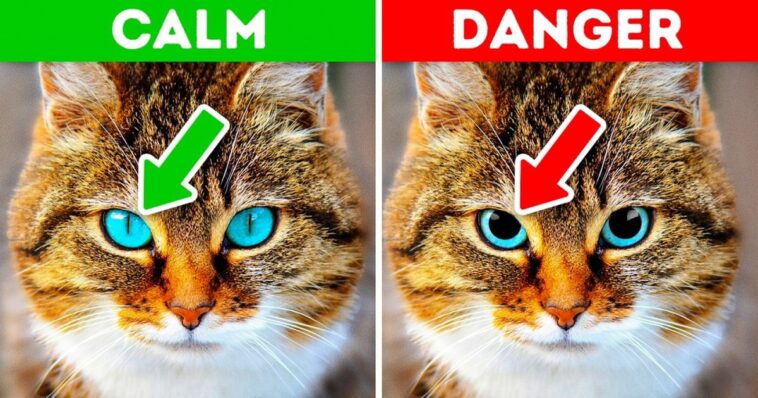Unfortunately, our pets can’t say out loud if something’s wrong. That’s why a good master should know the main symptoms of domestic animals’ diseases.
We found out which signs show that you should immediately take your pet to the vet instead of looking for answers on the Internet. And at the end of the article, there’s a little something that will let you better understand your furry friends in general.
12. Refusal to eat
If your pet refuses to eat for more than a day, it’s a serious reason to go to the vet immediately. Even more so if there are other symptoms like fatigue, vomiting, or refusal to drink.
A lack of appetite may indicate different conditions: infection, tumor, mouth or gastric diseases, or parasites. The vet will tell you what’s wrong for sure.

11. Extreme thirst
Remember that cats and dogs who eat dry pet food drink more than those on a wet food diet.
Watch how much your pet drinks. Lack of water leads to dehydration, while too much of it may indicate diabetes or kidney diseases.
The average volume of drinking water for dogs is about 20-70 ml/kg of body weight per day; for cats, it’s 60-120 ml plus the moisture in the food.

10. Your pet is hiding
Every animal is different, but when your normally friendly pet starts going off by itself and hiding in holes, it’s a bad sign.
The desire to hide may be related to feeling unwell, especially if the animal refuses to eat, has toilet issues, or other symptoms.
Another reason is severe stress.
If a cat tries to hide somewhere high, perhaps it’s being attacked by fleas.

9. Sudden aggression
Your formerly affectionate little friend has suddenly become aggressive? Before punishing it, find out the reason.
One may be pain, especially if the pet’s getting angry when you touch it.
Dental issues, arthritis, injuries, infections – these are just a few conditions that may alter a pet’s mood and cause it pain.

8. Frequent urinating
If your cat or dog has begun using its toilet more often or the color of its urine has changed, don’t ignore it, especially if your pet takes frequent false attempts to urinate.
Remember that puppies and old dogs use the toilet more often.
However, serious health issues may cause such behavior too, such as urine incontinence, diabetes, urinary tract infections, or kidney diseases.

7. Your pet licks itself too much
Excess self-cleaning in cats may mean health issues. One of the reasons is that the area it’s licking is itching or painful from inside, or it might be fleas or an allergy. Sometimes, cats lick themselves hard because of stress or anxiety.
If your dog licks its paws between the claws, the area by the tail, or between the hips, it’s a sign of an allergy. If a dog licks unusual objects (the floor or walls) or frequently wets its lips, then it could be a gastrointestinal disorder.

6. Something’s wrong with your pet’s eyes
Red eyes, secretion from the eyes, or a prolapsed third eyelid are all true symptoms of viruses and bacterial infections. For example, clear secretion from a cat’s eyes means it’s a virus, while yellow or green ones tell of an infection.
Red eyes may also mean an injury, allergy, corneal diseases, or serious systemic diseases.

5. Your pet sleeps longer than usual
Cats can sleep up to 13-16 hours a day or even longer if they’re bored. Yet there are other reasons for prolonged sleep: stress, peritonitis, leukosis, Lyme disease, or even feline immunodeficiency virus. Better go to the vet to be sure.
In dogs, excess sleep may indicate thyroid gland issues, diabetes, infections, or stress.

4. The coat is altered
A sick cat doesn’t have the strength to lick itself and keep its coat clean. One of the reasons for this is arthritis.
If your pet is shedding too much fur, it’s also a dangerous sign. The animal may be suffering from skin diseases, malnutrition, lack of vitamins, allergies, or even a tumor.

3. Breathing problems
If your pet has difficulty breathing without any serious physical exercise, take it to the vet immediately!
Such a condition can be dangerous, and the reasons for it are numerous, ranging from liquid in the chest to heart issues.

2. Change of the gums’ color
Cats and dogs normally have pink gums, except for those born with black ones. If the color has changed, take your pet to the vet.
White gums indicate loss of blood; red ones of high fever, infection, toxic substances, or dental problems; blue or purple tell of a lack of oxygen; yellow ones indicate liver issues.

1. Your pet is constantly staring at a wall
Of course, they might see something we can’t. But, unfortunately, the reason is usually much more serious. A cognitive dysfunction syndrome, convulsions, or dizziness may be symptoms of head injuries, tumors, encephalitis, poisoning, stroke, and more.

Bonus: How to understand if your cat is angry
It can be hard to realize that your pet is aggressively disposed, and its reaction to you may be unexpected. Luckily, there’s a distinct marker of anger in cats: their eyes. Normally, a cat’s eyes would be wide open or half-closed with the pupils narrow and vertical. If, however, the pupils are wide and round, it’s almost a sure sign that you shouldn’t touch your kitty just now.



